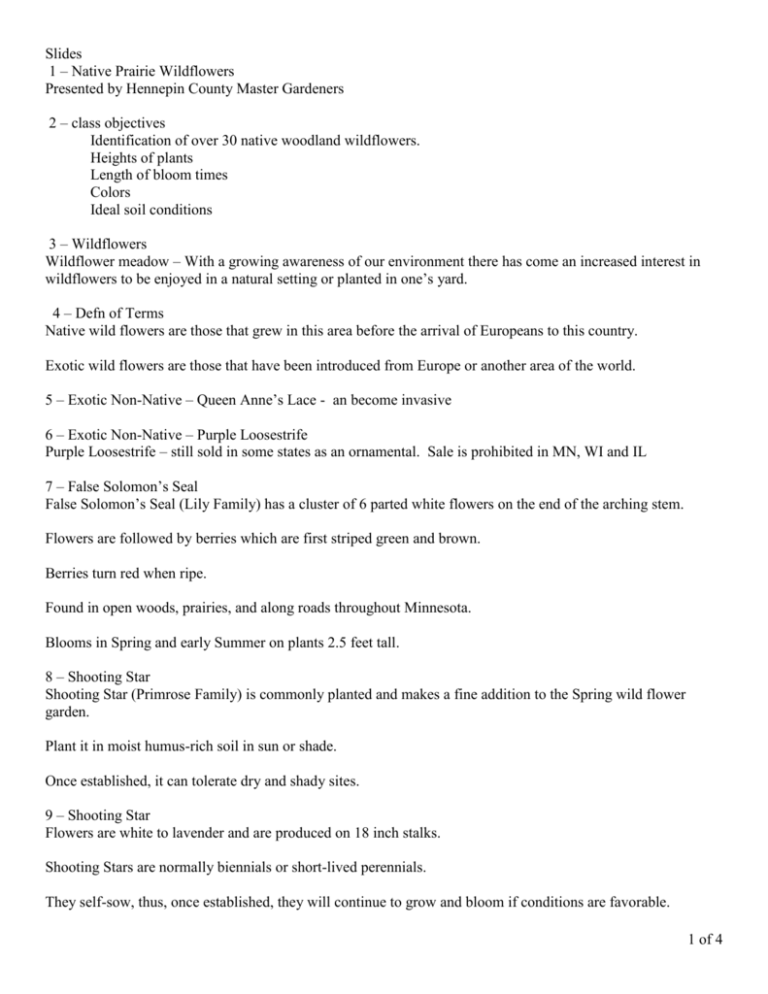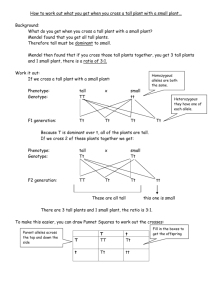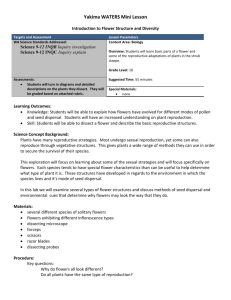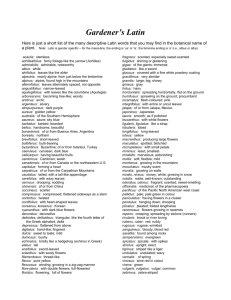Text – Native prairie wildflowers - University of Minnesota Extension
advertisement

Slides 1 – Native Prairie Wildflowers Presented by Hennepin County Master Gardeners 2 – class objectives Identification of over 30 native woodland wildflowers. Heights of plants Length of bloom times Colors Ideal soil conditions 3 – Wildflowers Wildflower meadow – With a growing awareness of our environment there has come an increased interest in wildflowers to be enjoyed in a natural setting or planted in one’s yard. 4 – Defn of Terms Native wild flowers are those that grew in this area before the arrival of Europeans to this country. Exotic wild flowers are those that have been introduced from Europe or another area of the world. 5 – Exotic Non-Native – Queen Anne’s Lace - an become invasive 6 – Exotic Non-Native – Purple Loosestrife Purple Loosestrife – still sold in some states as an ornamental. Sale is prohibited in MN, WI and IL 7 – False Solomon’s Seal False Solomon’s Seal (Lily Family) has a cluster of 6 parted white flowers on the end of the arching stem. Flowers are followed by berries which are first striped green and brown. Berries turn red when ripe. Found in open woods, prairies, and along roads throughout Minnesota. Blooms in Spring and early Summer on plants 2.5 feet tall. 8 – Shooting Star Shooting Star (Primrose Family) is commonly planted and makes a fine addition to the Spring wild flower garden. Plant it in moist humus-rich soil in sun or shade. Once established, it can tolerate dry and shady sites. 9 – Shooting Star Flowers are white to lavender and are produced on 18 inch stalks. Shooting Stars are normally biennials or short-lived perennials. They self-sow, thus, once established, they will continue to grow and bloom if conditions are favorable. 1 of 4 They like open woods and prairies. 10 – May Apple May Apple (Barberry Family) is an attractive wildflower, 1-1.5 feet tall, that forms a dense mat. Its large, opposite leaves are palmate compound. Then the leaves first emerge in the Spring, they resemble an opening umbrella. They like rich, damp soils and are found in woods and pastures in the Spring. 11 – May Apple A large showy white flowers develops in the axel of the two opposite leaves. Like the Wild Ginger, the flowers are usually covered by the leaves. A fleshy fruit resembling an apple develops in mid-Summer. The green apple as well as all other portions of the plant are POISONOUS. 12 – Wild Geranium The Wild Geranium (Geranium Family) is a common woodland plant throughout eastern Minnesota. It has pale rosy-purple flowers. It blooms in Spring and Summer and grows to 1-2 feet tall. This and closely related species are often planted in a shaded perennial border. Commonly called Cranesbills because its seed pods have a rigid tapered “beak”. It likes moist, well-drained soils in the sun or shade of woods, thickets, and meadows. 13 – Cardinal Flower The Cardinal Flower (Lobelia family) is one of our most showy wildflowers. It grows 2- 3 feet tall in moist meadows and along streams in southeastern Minnesota. It is a short-lived perennial but reseeds itself in sites to its liking. It is easily grown from seed and blooms nicely in the flower border with some extra attention to watering. Blooms in July-September 14 – Bird’s Foot Violet Bird’s Foot Violet thrives in average, sandy or loamy, well drained soil in full sun or light shade. Bird’s Foot Violet produces a deeply lobed leaf which resembles the foot of some fanciful bird, hence its name. 15 – Swamp Milkweed The perennial Swamp Milkweed (Milkweed family) is attractive in flower and the seedpods are prized for dried arrangements. It grows 2- 6- feet tall. The flowers last for several weeks when used in flower arrangements. Found throughout Minnesota, it blooms in July-August. The milky juice in the stem gives the plant its common name. 2 of 4 On-inch flowers may be white, pink or lavender. 16 – Common or Showy Milkweed Common or Showy Milkweed grows 1-3 feet tall in rich evenly moist soil. However, established plants can tolerate dry soils. The fragrant, sticky flowers attract butterflies. 17 – Common or Showy Milkweed The seed pods open to distribute many seeds to the wind. Here is a close-up of the seed pod of Common or Showy Milkweed. 18 – Bottle or Closed Gentian The perennial Bottle or Closed Gentian (Gentian family) is common in wet meadows, open woods and along lakeshores. The flowers remain closed. White forms are sometimes found in addition to the typical bluishpurple ones. It grows 1- to 2- feet tall and blooms in August-September in sun or partial shade from moist rich soils. 19 – Pasque Flower The Pasque Flower (Buttercup family) is the state flower of South Dakota. Its crocus-like blue flowers are among the first of our wildflowers to open in the spring, often being in full bloom by mid-April. It requires a sunny location and a well-drained, rocky or gravelly soil. It is found along railroad rights of way and other undisturbed sites. Stems are quite hairy. 20 – Wild Lupine The Wild Lupine (Bean family) is common in well-drained acid, sandy soil in central and north central Minnesota. It grows in open woods and in old fields. It grows 1- to 3- feet tall with 12” high flower spikes that bloom in May-June. It is easy to collect seeds in October along the North Shore, although it may be difficult to establish. 21 – Butterfly Weed The Butterfly Weed or Milkweed (Milkweed family) is another native of the sandy soils of east-central Minnesota. It grows 1- to 2- feet tall in the open as well as in the woodland openings. Once established from brittle, fleshy tap roots, it tolerates full scorching sun and dry soils without wilting. Spider mites may be a problem in the hottest, driest portion of the summer. Grown from seed or root cuttings, it makes an attractive perennial in the flower border. Here is a close-up of its orange-red flowers that bloom in July-August. Butterfly Weed belongs to the milkweed family. 22 – Harebell The Harebell (Bellflower family), also called Bluebells of Scotland, is one of our most common wildflowers, growing in poor rocky or sandy soils in full sun throughout most of the state. It is very common in rock crevices on the north shore of Lake Superior, and odes well in rock gardens. Only six inches tall, it blooms from June through September. 23 – Turk’s Cap Lily The Turk’s Cap Lily (Lily family) is quite common in moist meadows in full sun in the eastern half of the state. It is yellow to red-orange, dotted with purple. It grows 3- to 5- feet tall and blooms in July- August. 24 – Gray-Headed Coneflower 3 of 4 Gray-Headed Coneflower (Composite family) rays are yellow, long, narrow and drooping. Raised center knobs can be gray or brown. It has a hairy stem. A member of the sunflower family, it is drought tolerant and likes dry woods and open prairies. It grows 1- to 3-feet tall and flowers in July-September. 25 – Blazing Star or Gay Feather This showy flower is called Blazing Star or Gay Feather (Composite family), depending on the variety. It is found on open prairies and has spike-like, densely clustered, rosy-purple flowers on tall stems. It is one of few flowers which bloom from top to bottom. Depending on the variety, it can be 1- to 4- feet tall. Most varieties like a dry soil. Here is a close-up of the flower. Though usually purple, some flowers are white. It flowers in July-September. 26 – Rough or Button Gay feather Rough or Button Gay Feather (Composite family) is another variety. Both varieties prefer rich, moist soil in full sun. To prevent damage from mice and voles, which love to eat the corms, line the planting hole with hardware cloth (chicken wire). 27 – Ozark Sun Drops or Missouri Primrose The flowers of Ozark Sun drops or Missouri Primrose (Evening Primrose family) are 3” to 4” across with 4 overlapping lemon yellow poppy-like flowers. Each flower lasts but one day. Plant this flower in average, sandy to loamy well-drained soil in full sun. 28 – Obedient plant Obedient plant (Mint family) flowers on 3 to 4 foot stems with showy pink flowers. As a member of the mint family, the plants spread quickly with creeping stems and fibrous roots. “Obedient” refers to the tendency of the plant to hold its flowers in place once bent into a position. Plant in moist, humus-rich soil in full sun to partial shade. These plants can be heavy feeders. 29 – Wild Bergamot Wild Bergamot (Mint family) produces 3” wide lavender to pale pink flower heads atop 2 to 4 ft. stems. Although it is susceptible to powdery mildew, if the foliage is cut down after flowering, the new foliage will be fresh and mildew free. However, if you do not cut down the plant after flowering, you will be rewarded with the fall and winter interest of its seed pods. Plant Wild Bergamot in average to rich well-drained soil in full sun or partial shade. 30 – New England Aster New England Aster (Composite family) is one of our common fall flowers. Its daisy like flowers range from rosy-lilac to violet-purple. It grows 2- to 3- feet tall and grows best in moist to wet soils in full sun. 31 – Purple Coneflower The Purple Coneflower (Composite family) is a native in open woods and prairies. A narrow-leaved species E. august folia is native in western Minnesota. Purple Coneflower is often grown in the perennial flower border. It grows 2- to 3- feet tall and is drought tolerant. 32 – Summary Native Prairie Wildflowers are a beautiful natural addition to a garden that will add beauty for years to come 33 – Questions 34 – Thank You 4 of 4









